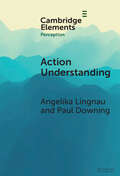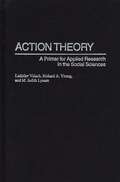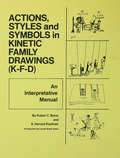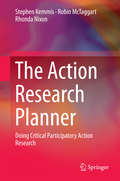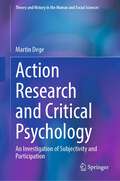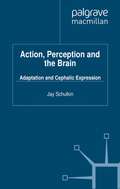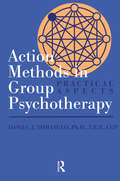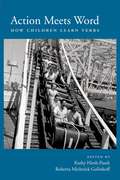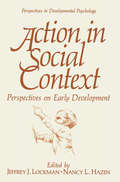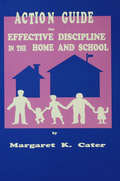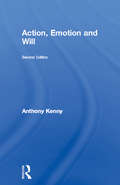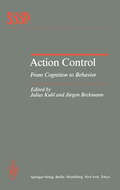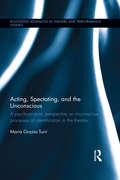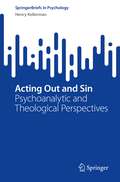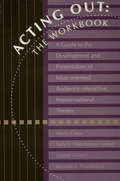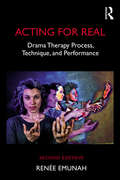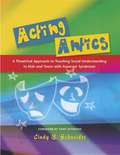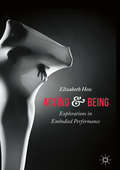- Table View
- List View
Action Understanding (Elements in Perception)
by null Angelika Lingnau null Paul DowningThe human ability to effortlessly understand the actions of other people has been the focus of research in cognitive neuroscience for decades. What have we learned about this ability, and what open questions remain? In this Element the authors address these questions by considering the kinds of information an observer may gain when viewing an action. A 'what, how, and why' framing organises evidence and theories about the representations that support classifying an action; how the way an action is performed supports observational learning and inferences about other people; and how an actor's intentions are inferred from her actions. Further evidence shows how brain systems support action understanding, from research inspired by 'mirror neurons' and related concepts. Understanding actions from vision is a multi-faceted process that serves many behavioural goals, and is served by diverse mechanisms and brain systems.
Action Theory: A Primer for Applied Research in the Social Sciences (Non-ser.)
by Ladislav Valach Richard A. Young M. Judith LynamThe authors describe a view that our short-, medium-, and long- term behavior, interactions, and relationships—whether planned or spontaneous, purposeful or playful—can be understood in terms of goal-directed systems. An understanding of action theory and research methods used in applied settings is provided. It leads to the conclusion that individual processes are joint processes and the joint construction of lives should be monitored to understand ongoing personal and social involvements.The unique contribution of this book lies in its bringing together and extending of basic features of the theory of goal-directed action systems previously published in a range of scattered research and conceptual articles in the literature. Professionals including clinicians, counselors, social workers, researchers, doctors, nurses, and physical or occupational therapists will find in this book an accessible means to understand, act on, research, and intervene in the behavioral processes they encounter in everyday work.
Action, Styles, And Symbols In Kinetic Family Drawings Kfd
by Robert C. Burns S. Harvard KaufmanFirst published in 1972. Routledge is an imprint of Taylor & Francis, an informa company.
Action, Styles, And Symbols In Kinetic Family Drawings Kfd
by Robert C. Burns S. Harvard KaufmanFirst published in 1972. Routledge is an imprint of Taylor & Francis, an informa company.
The Action Research Planner: Doing Critical Participatory Action Research
by Stephen Kemmis Robin McTaggart Rhonda NixonA fully-updated and reworked version of the classic book by Stephen Kemmis and Robin McTaggart, now joined by Rhonda Nixon, The Action Research Planner is a detailed guide to developing and conducting a critical participatory action research project. The authors outline new views on ‘participation’ (based on Jürgen Habermas’s notion of a ‘public sphere’), ‘practice’ (as shaped by practice architectures), and ‘research’ (as research within practice traditions). They provide five extended examples of critical participatory action research studies. The book includes a range of resources for people planning a critical participatory research initiative, providing guidance on how to establish an action research group and identify a shared concern, research ethics, principles of procedure for action researchers, protocols for collaborative work, keeping a journal, gathering evidence, reporting, and choosing academic partners. Unlike earlier editions, The Action Research Planner focuses specifically on critical participatory action research, which occupies a particular (critical) niche in the action research 'family'. The Action Research Planner is an essential guide to planning and undertaking this type of research.
Action Research and Critical Psychology: An Investigation of Subjectivity and Participation (Theory and History in the Human and Social Sciences)
by Martin DegeThis book examines the theoretical developments in the field of Action Research from a historical perspective. The central focus of the investigation is the concepts of democracy and subjectivity as defined by the field’s various traditions. To address this issue, this book offers a thorough investigation of the theoretical and historical underpinnings of Action Research in order to argue that such a clarification allows for a transcendence of the distinction between theory and practice in political action. This transcendence will be achieved with the theories of the German critical psychologist Klaus Holzkamp and his interpretation of subjectivity and democracy. Holzkamp establishes a comprehensive mode of change based on the contradiction of existing possibilities for action and restrictions in a concretely given empirical situation. This book is aimed at History of Psychology Classes, Social Workers, Activism Researchers, Undergraduate Courses in Critical Thinking and Political Action, and Decolonial Theory in Psychology.
Action, Perception and the Brain: Adaptation and Cephalic Expression (New Directions in Philosophy and Cognitive Science)
by Jay SchulkinTheories of brain evolution stress communication and sociality are essential to our capacity to represent objects as intersubjectively accessible. How did we grow as a species to be able to recognize objects as common, as that which can also be seen in much the same way by others? Such constitution of intersubjectively accessible objects is bound up with our flexible and sophisticated capacities for social cognition understanding others and their desires, intentions, emotions, and moods which are crucial to the way human beings live. This book is about contemporary philosophical and neuroscientific perspectives on the relation of action, perception, and cognition as it is lived in embodied and socially embedded experience. This emphasis on embodiment and embeddedness is a change from traditional theories, which focused on isolated, representational, and conceptual cognition. In the new perspectives contained in our book, such 'pure' cognition is thought to be under-girded and interpenetrated by embodied and embedded processes.
Action Methods In Group Psychotherapy: Practical Aspects
by Daniel J. TomasuloFirst published in 1999. Routledge is an imprint of Taylor & Francis, an informa company.
Action Methods In Group Psychotherapy: Practical Aspects
by Daniel J. TomasuloFirst published in 1999. Routledge is an imprint of Taylor & Francis, an informa company.
Action Meets Word: How Children Learn Verbs
by Kathy Hirsh-Pasek Roberta Michnick GolinkoffAlthough there has been a surge in our understanding of children's vocabulary growth, theories of word learning lack a primary focus on verbs and adjectives. Researchers throughout the world recognize how our understanding of language acquisition can be at best partial if we cannot comprehend how verbs are learned. This volume represents a proliferation of research on the frontier of early verb learning, enhancing our understanding of the building blocks of language and considering new ways to assess key aspects of language growth.
Action in Social Context: Perspectives on Early Development (Perspectives in Developmental Psychology)
by Jeffrey J. Lockman and Nancy L. HazenThis is a book about the development of action and skill in the first years of life. But it differs in an important way from most past treatments of the subject. The present volume explores how the development of ac tion is related to the contexts, especially the social ones, in which actions function. In past work, little attention has focused on this relationship. The prevailing view has been that infants develop skills on their own, independent of contributions from other individuals or the surrounding culture. The present volume is a challenge to that view. It is based on the premise that many early skills are embedded in interpersonal activities or are influenced by the activities of other individuals. It assumes further that by examining how skills function in interpersonal contexts, insights will be gained into their acquisition and structuring. In effect, this vol ume suggests that the development of cognitive, perceptual, and motor skills needs to be reexamined in relation to the goals and contexts that are inherently associated with these skills. The contributors to the vol ume have all adopted this general perspective. They seek to understand the development of early action by considering the functioning of action in context. Our motivation for addressing these issues stemmed in part from a growing sense of dissatisfaction as we surveyed the literature on skill development in early childhood.
Action Guide For Effective Discipline In The Home And School
by Margaret K. CaterFirst published in 1992. Routledge is an imprint of Taylor & Francis, an informa company.
Action Guide For Effective Discipline In The Home And School
by Margaret K. CaterFirst published in 1992. Routledge is an imprint of Taylor & Francis, an informa company.
Action, Emotion and Will: 1963 Edition
by Dr Anthony Kenny Anthony KennyAction, Emotion and Will was first published in 1963, when it was one of the first books to provoke serious interest in the emotions and philosophy of human action. Almost forty years on, Anthony Kenny's account of action and emotion is still essential reading for anyone interested in these topics.The first part of the book takes an historical look at the emotions in the work of Descartes, Locke and particularly Hume. In the second part, Kenny moves on to discuss some of the experimental work on the emotions by 20th Century psychologists like William James. Separate chapters cover feelings, motives, desire and pleasure. This edition features a brand new preface by the author.
Action, Emotion and Will
by Dr Anthony Kenny Anthony KennyAction, Emotion and Will was first published in 1963, when it was one of the first books to provoke serious interest in the emotions and philosophy of human action. Almost forty years on, Anthony Kenny's account of action and emotion is still essential reading for anyone interested in these topics.The first part of the book takes an historical look at the emotions in the work of Descartes, Locke and particularly Hume. In the second part, Kenny moves on to discuss some of the experimental work on the emotions by 20th Century psychologists like William James. Separate chapters cover feelings, motives, desire and pleasure. This edition features a brand new preface by the author.
Action Control: From Cognition to Behavior (Springer Series in Social Psychology)
by JürgenBeckmann JuliusKuhl"It is not thought as such that can move anything, but thought which is for the sake of something and is practical." This discerning insight, which dates back more than 2000years to Aristotle, seems to have been ignored by most psycholo gists. For more than 40years theories of human action have assumed that cogni tion and action are merely two sides of the same coin. Approaches as different as S-O-R behaviorism,social learning theory, consistency theories,and expectancy value theories of motivation and decision making have one thing in common: they all assume that "thought (or any other type of cognition) can move any thing," that there is a direct path from cognition to behavior. In recent years, we have become more and more aware of the complexities in volved in the relationship between cognition and behavior. People do not always do what they intend to do. Aside from several nonpsychological factors capable of reducing cognition-behavior consistency, there seems to be a set of complex psychological mechanisms which intervene between action-related cognitions, such as beliefs, expectancies, values, and intentions,and the enactment of the be havior suggested by those cognitions. In our recent research we have focused on volitional mechanismus which presumably enhance cognition-behavior consistency by supporting the main tenance of activated intentions and prevent them from being pushed aside by competing action tendencies.
Acting, Spectating and the Unconscious: A psychoanalytic perspective on unconscious mechanisms of identification in spectating and acting in the theatre. (Routledge Advances in Theatre & Performance Studies)
by Maria Grazia TurriFrom Aristotle’s theory of tragic katharsis onwards, theorists of the theatre have long engaged with the question of what spectatorship entails. This question has, directly or indirectly, often been extended to the investigation of acting. Acting, Spectating, and the Unconscious approaches the unconscious aspects of spectatorship and acting afresh. Interweaving psychoanalytic descriptions of processes such as transference, unconscious phantasy, and alpha-function with an in-depth survey of theories of spectating and acting from thinkers such as Brecht, Diderot, Rousseau and Plato, Maria Grazia Turri offers a significant insight into the emotions inherent in both the art of the actor, and the spectator’s experience. A compelling investigation of the unconscious communication between spectators and actors, this volume is a must-read for students and scholars fascinated by theatre spectatorship.
Acting, Spectating and the Unconscious: A psychoanalytic perspective on unconscious mechanisms of identification in spectating and acting in the theatre. (Routledge Advances in Theatre & Performance Studies)
by Maria Grazia TurriFrom Aristotle’s theory of tragic katharsis onwards, theorists of the theatre have long engaged with the question of what spectatorship entails. This question has, directly or indirectly, often been extended to the investigation of acting. Acting, Spectating, and the Unconscious approaches the unconscious aspects of spectatorship and acting afresh. Interweaving psychoanalytic descriptions of processes such as transference, unconscious phantasy, and alpha-function with an in-depth survey of theories of spectating and acting from thinkers such as Brecht, Diderot, Rousseau and Plato, Maria Grazia Turri offers a significant insight into the emotions inherent in both the art of the actor, and the spectator’s experience. A compelling investigation of the unconscious communication between spectators and actors, this volume is a must-read for students and scholars fascinated by theatre spectatorship.
Acting Out and Sin: Psychoanalytic and Theological Perspectives (SpringerBriefs in Psychology)
by Henry KellermanThis brief treatise explores the common threads to psychoanalytic thought and theological theory. It uses a psychoanalytic lens to examine Judeo/Christian concepts of individual will, consciousness and the unconscious, and the apparent confounding idea of sin. What is new is that the definition of sin is revealed as a psychoanalytic translation of acting-out. Focusing on the behavior of acting-out it illuminates ideas that are part of Western cultural tradition providing insights to those interested in the psychology, and its history and philosophy. As such, it is a highly relevant work for psychologists, psychiatrists, and psychoanalysts, as well as for a comparative study of psychoanalytic and theological intersecting structures.
Acting Out: A Guide To The Development And Presentation Of Issue-Oriented, Audience- interactive, improvisational theatre
by Mario Cossa Sally Ember Lauren Glass Jennifer RussellFirst published in 1996. Routledge is an imprint of Taylor & Francis, an informa company.
Acting Out: A Guide To The Development And Presentation Of Issue-Oriented, Audience- interactive, improvisational theatre
by Mario Cossa Sally Ember Lauren Glass Jennifer RussellFirst published in 1996. Routledge is an imprint of Taylor & Francis, an informa company.
Acting For Real: Drama Therapy Process, Technique, And Performance
by Renée EmunahThis second edition takes the reader further into the heart of using drama for healing. Dr. Emunah offers an expanded understanding of her Integrative Five Phase model, a foundational approach that embraces the wide spectrum of possibilities within the playing field of drama therapy. Grounded by compassionate clinical examples, including ones that reach over time into deep-seated issues, the book offers tools for action-oriented treatment, embodied therapeutic interventions, and creatively engaging a wide variety of clients. This comprehensive text also contains over 120 techniques, categorized by phases in the session and treatment series, and subcategorized by therapeutic objective. Process-oriented drama therapy with group and individuals, as well as performance-oriented forms, are described in vivid detail. New to the second edition is an exploration of drama therapy outside of the clinical arena, including dramatic methods in family life and parenting, and drama therapy geared toward social change.
Acting For Real: Drama Therapy Process, Technique, And Performance
by Renée EmunahThis second edition takes the reader further into the heart of using drama for healing. Dr. Emunah offers an expanded understanding of her Integrative Five Phase model, a foundational approach that embraces the wide spectrum of possibilities within the playing field of drama therapy. Grounded by compassionate clinical examples, including ones that reach over time into deep-seated issues, the book offers tools for action-oriented treatment, embodied therapeutic interventions, and creatively engaging a wide variety of clients. This comprehensive text also contains over 120 techniques, categorized by phases in the session and treatment series, and subcategorized by therapeutic objective. Process-oriented drama therapy with group and individuals, as well as performance-oriented forms, are described in vivid detail. New to the second edition is an exploration of drama therapy outside of the clinical arena, including dramatic methods in family life and parenting, and drama therapy geared toward social change.
Acting Antics: A Theatrical Approach to Teaching Social Understanding to Kids and Teens with Asperger Syndrome (PDF)
by Cindy Schneider Tony Attwood`The ideas are excellent and well laid out… This is an innovative approach to social skills training for students with Asperger's Syndrome who will tolerate acting, and for a group leader with energy and commitment to drama.' -Speech and Language Therapy in Practice `Schneider's enthusiasm for the subject and her passion to improve life skills of young people is very evident and encourages the reader to progress…As a catalogue of practical ideas with built-in resources, this is a useful book for support groups and families wishing to create a theatre group. Acting Antics has an easy-to-read format and includes activities that can be initiated with minimum preparation and resources.' -Children Now Magazine, 2007 This fun and inspiring step-by-step program provides the full set of tools for developing social understanding in children with Asperger Syndrome (AS) through drama. Cindy B. Schneider explains how the central processes in acting - including making and interpreting inferences from non-verbal cues, taking another's perspective, and formulating language - can be highly effective ways of addressing social cognition deficits in children with AS. Acting Antics contains a wide repertoire of activities and ideas for immediate application at home, in the classroom, in therapy workshops or social groups, ranging from initial warm up techniques, through paired activities, to larger group scenes and staging a show. Helpful appendices provide questionnaire forms to enable both the child and the program leader to assess and monitor the child's understanding of their roles, along with reproducible scripts and suitable scene designs. This complete, practical program provides a wealth of enjoyable educational ideas for parents, teachers, and therapists of children with Asperger Syndrome.
Acting and Being: Explorations in Embodied Performance
by Elizabeth HessIn this book, educator-actor-playwright-director Elizabeth Hess offers systematic and original explorations in performance technique. This hybrid approach is a fusion of physical theater modalities culled from Western practices (Psycho-physical actions, Viewpoints) Eastern practices (Butoh, Kundalini yoga) and related performance disciplines (Mask, Puppetry). Behavioral, physiological and psychological ‘states of being’ are engaged to unlock impulses, access experience and enlarge the imagination. Through individual, partnered and collective explorations, actors uncover a character’s essence and level of consciousness, their energy center and body language, and their archetype and relationship to universal themes. Magic (to pretend, as if), Metaphor (to compare, as like) and Myth (to pattern after, as in) provide the foundation for generating transformative, empathetic and expansive artistic expression. Explorations can be adapted to character work, scene study and production, including original/devised work and established text, to illuminate singular and surprising work through collaborative creativity that is inventive, inclusive and alive.
